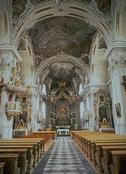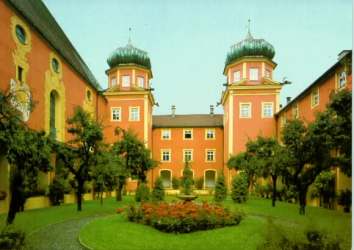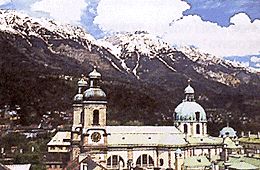| |
|
|
| |
Historically grown cultural center with 800jaehriger
past. City of the art treasures, famous for its "golden Dachl",
"black Mander", the imperial yard castle and lock the Ambras.
Alive history, connected with large names such as emperors Maximilian
I. and Maria Theresia. Combat place around Tiroler liberty and sporty
medals. City-stroll and summit victory. Tiroler evening, blowing music
and baroque opera, leather trousers and tuxedo. University -, congress
and purchase city.
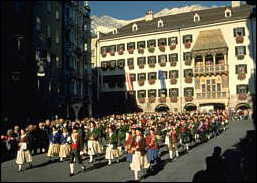
|
|
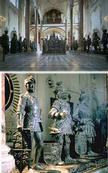 |
Yard church with silver chapel
1553 -, one builds the yard church for 1563, under Ferdinand I.. It
contains the empty grave monument emperor Maximilians I., the Sarkophag
with kneel-ends emperors, at the sides is 24 marble reliefs with the
acts of the emperor to be seen, and as dead escort 28 survive-large
bronze statues. The grave monuments of Andreas Hofer and of other freedom
fighters are likewise in the yard church. Opening times:
Monday - Saturday: 9,00-17,00 o'clock
|
|
| |
|
|
| |
|
|
| |
|
|
|
|
The Wiltener Basilika, Pfarr and pilgrimage
church, belongs to the art jewels of Innsbruck. As the legend reports,
already Roman Legionaere at this place a Marienbild admired. 1140 were
taken over their support by the medal of the Praemonstratenser. one
already heard 1259 of the church of "our high wife", to whom
in the consequence an active barrier travel movement began. Soon the
existing church became too small; one converts it several times. Again
because of state of decay it was established to 1751-56 by the building
master and minister Franz de Paula Penz after plans of Josef Stapf (feet).
Before the Basilika lies a larger place, which lets the beautiful baroque
front particularly become effective. The inside the Basilika is mixed
an intoxication tender ester colors, with festive gold and delicate
Rococo stucco, which Franz Xaver Feichtmayr and Anton Gigl actually
put as Gespinst over those strict architecture. M. Guenther from Augsburg
created the splendourful cover paintings, which show scenes from the
life Mariens. The plastic decoration originates from Josef Stapf from
feet, likewise the statues on the pulpit. Splendour-fully also the high
altar with the four columns. They surround the structure of altar, which
is considered by a giant crown. Among them in the strahlenkranz the
grace picture, one about 90 cm high nut/mother God statue with child
from sandstone, in the style hochgotisch, from the first half 14. Jhd.
|
|
| |
|
|
|
|
The area at the Bergisel was
already at present the urn field period (approx. 1000 v. Chr.)besiedelt.
The Romans had approximately, where today pin stands, their settlement
and the castellet "Veldidena". Around 565 in a report on a journey
a Laurentiuskirche is mentioned here.After
the legend a giant named Haymon, a Germanic immigrant is after a fight
with the native giant Tyrsus, which he had killed thereby, to the Suehne
a monastery built (around 878). The Haymonstatue in the input area pin-church-holds
the tongue from it defeated in the Sillschlucht living kite in the left
hand. A convention of world priests
was when desired replaced still 1138 ago the Brixener Dioezesanbischofs
from Praemonstratensern from red at the red. At the 30.April 1138 Pope
Innozenz II. confirmed their community. 1180
left the Wilten the count von Andechs Berthold III areas to pin to the
right Innseite, so that could establish to this those-today's old part
of town of Innsbruck. Among other things count Berthold gave the so-called
Wiltener handle cup, a Saxonian work of that time to the pin. The choir
gentlemen took over at that time the three Urpfarren Wilten, Ampass and
Patsch, out those later the 21 Pfarreien developed, which care for the
priests of the pin today seelsorglich. A large bloom time experienced
that pin in 17. and 18.Jahrhundert. At that time one builds the baroque
monastery, after the for the time being romanischenGebaeude became destroyed
by fires, existing today, and the gotische monastery plant established
then through denEinsturz the church tower wurde.Im year 1665 the baroque
pin church inaugurated.
|
|
| |
|
|
|
|
The building of baroque became from 1717 - 24 in place of older churches
builds. The building of predecessors originated from the gothic. At the
altar is the famous Maria helping picture of Lukas Cranach d.Ae., the
Deckenfresken and stucco works comes from the brothers Asam. From the
cathedral the Innsbrucker peace bell play (Carillon) rings out. The tomb
of ore duke Maximillian III. the German master of Caspar grass originates
from the year 1620. The cathedral was again opened to 1993 after 2-jaehriger
renovation. No inspection during the fairs! Please do not photograph.
Opening times: 7.00 to 20,00
o'clock daily.
Contact
Cathedral to st. James
cathedral place A-6020 Innsbruck
Austria
|
|
|
|
Ambras One
of the most beautiful Renaissance locks of Austria, oldest art and preparation
collection European-wide, by the Habsburger ore duke Ferdinand II (1529-1595;
Spanish hall, Portaitgalerie of European dynasties 14.-15.Jh., approx..
250 exhibits.
Opening times: 1.April to 31.Oktober
daily 10,00 to 17.00
November closed
1. December until 31 March: daily
except Tuesday 14,00 to 17.00
Shuttle bus starting from Maria Theresien road
|
|
| |
|
|


